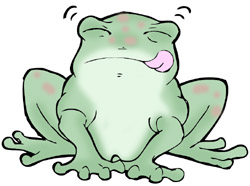INTERESTING FACTS
DID YOU KNOW??
AMPHIBIANS...
- Some don't croak, chirp, etc. their just silent.
- the brightly colored ones that come in blue, red, green yellow, bright pink etc. are poisonous. their color actually serves as a warning to other animals to not eat them.
- Some have teeth and some don't
- They have far less bones than humans do or any other vertebrates.
- Amphibians have 5 basic senses just like humans. But the things they are also known for is their ability to detect the Earth's magnetic field and infrared and ultraviolet light.
- They are the world's environmental indicators because they are very sensitive to any small changes to the environment.(because their ectothermic!)
- Amphibians are the most ancient class of land-living vertebrates. That is why many scientists believe that they were the first vertebrates that walked the earth and evolved, being the ancestors of many other species.
- There are over 5,500 species of amphibians in the world mostly found in upstate New York!
- Frog eggs are laid in a round bunch. Each bunch may have more than 500 eggs! Each egg is in a ball of clear jelly.
- Each egg starts to look like a tadpole in only after a day or two.
- In warmer water the eggs grow faster.
- To keep their skin thin and fresh, frogs molt as often as once every couple of days. A frog starts molting by eating the skin around its mouth. Then, it pulls the rest of the old skin over its head and eats it.
- the texture of a frog's skin and the shape of its body and legs vary from species to species
- The male species of the Darwin Frog actually swallows frogs eggs and keeps them in his throat until they hatch and pop out of his mouth.

- Frogs pull their eyes inside their head to help them swallow food.
- Goliath frogs, the biggest frogs, are thirty times bigger -- about 12.5 inches (32 cm) long from head to tail.
- There are actually 2 frogs in the world that has tails!--the coastal tailed frog and the mountain tailed frog.
TOAD FACTS
- Some toads such as the European Toad sheds its skin several times during the summer months and then eats it. This recycling habit keeps the toads skin healthy and full of goodness.
- Toads can generally stay farther away from water, since their skin doesn't dry out as quickly as frogs' skin.
FOR BOTH FROGS AND TOADS
- Every different kind of frog and toad makes its own special sound.
- The entire process of the tongue unrolling, catching the fly and then rolling back into the mouth takes less than a second!
- Big frogs and toads actually eat small fishes, reptiles and mammals.
- They have shorter backbones than the other two groups--salamanders & caecilians.
- Toads and Frogs have flattened skulls
- They are both in the order Anura which is the largest order with more than 3,500 species.
- Many frogs and toads are so poisonous that one can die in seconds once the toxin enters the bloodstream. That's why some tribal groups use the secretions from their skin to the tips of their arrows when hunting.
- GOOD PET FROGS
- The spotted salamander
- Australian green tree frog
- Regular toads
- Red-eyed tree frogs
- fire lizard
 |
| The fire lizard |
 |
| Red-eyed tree frog |
 |
| Yellow spotted salamander |
- Their limbs are roughly the same size as frogs and toads.
- larger salamanders are rough on their environment
- Some species of salamanders are capable of growing back limbs, tails and even eyes if they lose them.
- The gills look like feathers on the side of the head.
- Some newt and salamander species can squirt a toxic substance from special pores on their body to discourage predators -- sometimes up to six feet away!
- The order Urodela contains all newts and salamanders.
- There are about 360 species.
NEWT FACTS
- They outnumber the salamanders in North America
- Most simply, all newts are salamanders but not all salamanders are newts.DID YOU KNOW THAT!?
CAECILIAN FACTS
- Most live underground but some are aquatic!
- Caecilians make up the order Apoda.
- There are around 170 living species.


